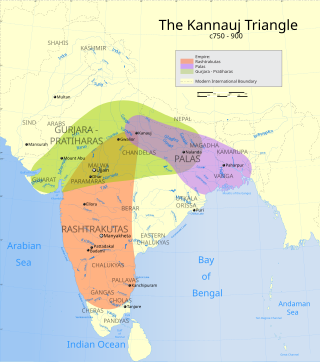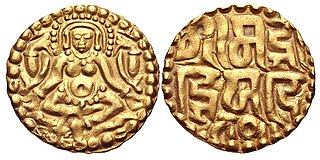Related Research Articles

Kannauj is a city, administrative headquarters and a municipal board or Nagar Palika Parishad in Kannauj district in the Indian state of Uttar Pradesh. The city's name is a corrupted form of the classical name Kanyakubja. It was also known as Mahodaya during the time of Mihira Bhoja. It is situated 123 kilometres west of the state capital, Lucknow.

The Gurjara-Pratihara was a dynasty that ruled much of Northern India from the mid-8th to the 11th century. They ruled first at Ujjain and later at Kannauj.
The Pāla Empire was an imperial power during the post-classical period in the Indian subcontinent, which originated in the region of Bengal. It is named after its ruling dynasty, whose rulers bore names ending with the suffix Pāla. The empire was founded with the election of Gopāla as the emperor of Gauda in late eighth century AD. The Pala stronghold was located in Bengal and eastern Bihar, which included the major cities of Gauḍa, Vikramapura, Pāṭaliputra, Monghyr, Somapura, Ramavati (Varendra), Tāmralipta and Jaggadala.

Bhoja was an Indian king from the Paramara dynasty. His kingdom was centered around the Malwa region in central India, where his capital Dhara-nagara was located. Bhoja fought wars with nearly all his neighbours in attempts to extend his kingdom, with varying degrees of success. At its zenith, his empire extended from Chittor in the north to upper Konkan in the south, and from the Sabarmati River in the west to Vidisha in the east.

The Gahadavala dynasty also Gahadavalas of Kannauj was a Rajput dynasty that ruled parts of the present-day Indian states of Uttar Pradesh and Bihar, during 11th and 12th centuries. Their capital was located at Banaras in the Gangetic plains, and for a brief period, they also controlled Kannauj.

Mihira Bhoja or Bhoja I was a king belonging to the Gurjara-Pratihara Dynasty. He succeeded his father Ramabhadra. Bhoja was a devotee of Vishnu and adopted the title of Ādivarāha which is inscribed on some of his coins. One of the outstanding political figures of India in ninth century, he ranks with Dhruva Dharavarsha and Dharmapala as a great general and empire builder.
Nagabhata II was an Indian Emperor from Gurjara-Pratihara dynasty. He ascended the throne of Gurjara-Pratihara dynasty after his father Vatsraja. His mother was queen Sundari-Devi. He was designated with imperial titles - Paramabhattaraka, Maharajadhiraja, and Paramesvara after conquest of Kannauj.

Dharmapala (ruled between 770s-810s AD) was the second ruler of the Pala Empire of Bengal and Bihar regions in the Indian subcontinent. He was the son and successor of Gopala, the founder of the Pala Dynasty. He greatly expanded the boundaries of the empire, and made the Palas a dominant power in the northern and eastern India.
Karna was an Indian king from the Chaulukya (Solanki) dynasty of Gujarat. He ruled the present-day Gujarat and surrounding areas, from his capital Anahilapataka.

The Paramara dynasty was an Indian dynasty that ruled Malwa and surrounding areas in west-central India between 9th and 14th centuries. They belonged to the Parmara clan of the Rajputs.

Yashovarman was a medieval Indian ruler of Kannauj, who founded the Varman dynasty of Kannauj. There are few sources that provide information of his life, although he was indubitably a powerful man.

The Chaulukya dynasty, also Solanki dynasty, was a dynasty that ruled parts of what are now Gujarat and Rajasthan in north-western India, between c. 940 CE and c. 1244 CE. Their capital was located at Anahilavada. At times, their rule extended to the Malwa region in present-day Madhya Pradesh. The family is also known as the "Solanki dynasty" in the vernacular literature. They belonged to the Solanki clan of Rajputs.
Munja, also known as Vakpati II, was an Indian ruler from the Paramara dynasty, who ruled in the Malwa region. He is known for consolidating the Paramara kingdom, for patronizing poets and scholars and for achieving the military success against almost all of the neighbouring kingdoms.

The Kalachuris of Tripuri, also known the Kalachuris of Chedi, ruled parts of central India during 7th to 13th centuries. They are also known as the Later Kalachuris to distinguish them from their earlier namesakes, especially the Kalachuris of Mahishmati. Their core territory included the historical Chedi region, and their capital was located at Tripuri.

The 11th century Paramara king Bhoja ruled from his capital at Dhara. The period of his reign is dated approximately 1010 CE to 1055 CE, although some historians believe that he ascended the throne before 1010 CE. Bhoja inherited a kingdom centered around the Malwa region, and made several attempts to expand it varying results. He managed to annex territories as far as northern parts of Konkan, but these territorial gains were short-lived. He fought wars against several of his neighbours, including the Chaulukyas of Gujarat, the Chalukyas of Lata, the Chalukyas of Kalyani, the Chandelas of Jejakabhukti, the Kachchhapaghatas of Gwalior, the Chahamanas of Shakambhari, the Chahamanas of Naddula, and the Kalachuris of Tripuri. He also conflicted with Gaznavid Turk Invaders, Mahmud's desecration of the Somnath temple in Gujarat motivated Bhoja to lead an army against him, however after Somnath raid, Mahmud Gazhnavi chose a more dangerous route via Sindh, to avoid facing the invading powerful armies of Bhoja.
Āma was a medieval Indian king who ruled Kannauj and surrounding areas during the 8th and the 9th centuries. According to the Jain chronicles, he was the son and successor of Yashovarman.
Lakshmikarna, also known as Karna, was a ruler of the Kalachuri dynasty of Tripuri in central India. His kingdom was centered around the Chedi or Dahala region in present-day Madhya Pradesh.
Bhoja was a medieval Indian king who ruled Kannauj in the late 8th century CE
The Ayudha dynasty was the short-lived, second dynasty of the Kannauj State from the late 8th to the early 9th century CE.

The Varman dynasty of Kannauj was a dynasty that ruled Kannauj and the surrounding areas from the mid 7th century to the late 8th century. It was founded by Yashovarman, who filled the power vacuum created after emperor Harshavardhana's death.
References
- 1 2 3 4 5 Rama Shankar Tripathi (1964). History of Kanauj: To the Moslem Conquest. Motilal Banarsidass. p. 211 ISBN 978-81-208-0478-4
- 1 2 3 4 5 6 7 Shyam Manohar Mishra (1977). Yaśovarman of Kanauj. Abhinav. pp. 120–121 OCLC 5782454
- ↑ The Gaüḍavaho: a historical poem in Prâkṛit (in Hindi). Government central book Departmentôt. 1887.
- ↑ Awasthi, Awadh Bihari Lal (1975). History from the Puranas. Kailash Prakashan.
- ↑ Sen, Sailendra Nath (1999). Ancient Indian History and Civilization (Paperback ed.). New Age International. pp. 264–668. ISBN 9788122411980.